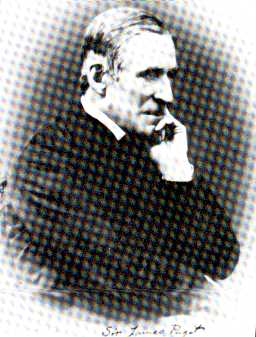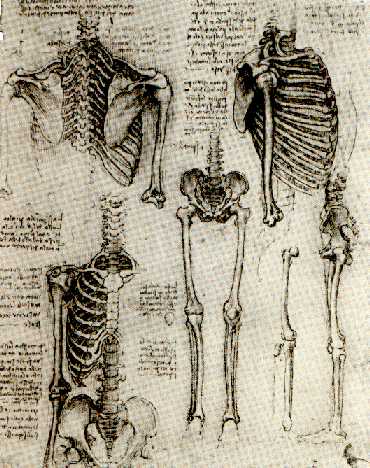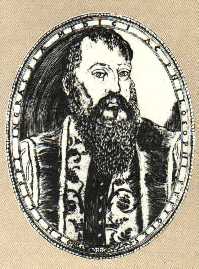For
centuries stories of famous explorers have been immensely
popular. Names such as Christopher Columbus and Vasco da Gama
have been familiar to generations of readers. Below are some
of the pioneers who explored the frontiers of the skeletal
system.

Coiter,
Volcher: Volcher Coiter, a physician who
established the study of comparative osteology, first
described cerebrospinal meningitis. Coiter's research
included human embryology as well as the comparative
osteology of animals.
Julius
Wolff: Wolff was a professor of orthopedic
surgery in Berlin who established Wolff's law. The Wolff's
Law states "All changes in the function of bones are
attended by definite alterations in their internal
structures".
Celus: Celus was a
Roman writer who contributed considerably to our knowledge of
the skeleton. He gave an account of the limbs and surgical
treatment.
Julius
Pollux: Pollux was a Roman contemporary whose
book Onomasticon
introduced many anatomical words such as 'trochanter' meaning
bony knob, like the one at the top of the thigh to which
muscles are attached.
Galen: Galen was a
famous philosopher who wrote hundreds of books, among which
one was Bones for Beginners.
Galen classified bones into those having a hollow marrow
cavity and those, like the bones of the skull, which do not.
He recognized that there are 24 vertebrae in the spine He
gave the name 'coccyx' to the rudimentary human tail. Galen
also described the sacrum, the block of fused vertebrae at
the base of the spine that forms the back part of the pelvic
girdle.

Sir
James Paget: Paget was a professor of anatomy who
discovered Paget's disease of bone, also called Osteitis
Deformans. The disease leads to deformity, fracture, and
imbalance in calcium metabolism. It is a common chronic
disease of middle age. He was the first to recommend surgical
removal of bone marrow tumors (myeloid sarcoma) instead of
amputation of the limb.

Leornardo
da Vinci: Leonardo was an artist and scientist.
He drew the first adequate picture of bones which were
anatomically correct.
Andreas
Vesalius: Vesalius is the founder of modern
observational anatomy. He produced the first comprehensive
account and illustrations of the human skeleton. He wrote De
Fabrica and Epitome of which the first
seven volumes were devoted to bones and joints. Vesalius
agreed with Galen on many things, but he also differed from
his ideas at certain points. He denied that humans have a
separate bone in the front part of the upper jaw, the
pre-maxillary bone. The bone of the skull, the sphenoid, was
first described by Vesalius. He also discovered the
Vesalianum or 'bone of Vesalius', which is a small, spherical
bone that exists between the base of the little toe and the
cuboid bone in the instep. It only exists when the base of
the inner bone of the little toe has separated.
E.
Donnall Thomas: He is an American physician who
pioneered techniques for transplanting bone marrow to treat
patients with diseases such as leukemia.
Claus
Worm: Worm was a physiologist who was the
first to describe the Wormian bones. These bones located in
the back of the skull are the result of a developmental
accident. If the cranial membrane in the fetus begins to
ossify away from the main centers of bone growth, they
persist into adulthood as small islands, adjacent or
incorporated in the lines that join the hard plates of the
skull. The Wormian bones are usually symmetrical.
Johann
Blumenbach: Blumenbach discovered the Blumenbach's
clivus, which is the sloping shelf of bone that leads up the
inside floor of the cranium from the foramen magnum (the hole
through which the spinal cord exits from the skull) to the
sella turcia (the pea-shaped cavity in the floor of the skull
which holds the pituitary gland).

Giovanni
Filipo Ingrassias: Ingrassias was an osteologist
who described the small part of the sphenoid bone which forms
the inner wall of the eye socket (apophysis of Ingrassias).
Charles
Marie Chassaignac: Chassaignar was a Parisian
surgeon who discovered the Chassaignac's tubercles that are
knobs that exist on both sides of the sixth cervical
vertebra. These knobs are vital in emergency surgery because
the main carotid arteries can be squeezed back against them
to stanch serious bleeding in the neck or face. Sudden
pressure on the carotid artery, which carried blood to the
brain, triggers a nervous reflex causing the heart to stop.
This is the fatal mechanism seen in death from the karate or
commando punch.
Pierre
Charles Alexander Louis: Louis was a Parisian chest
physician who discovered the 'Angle of Louis' which is the
name given to the slight bend towards the top of the
breastbone. He made detailed observations of chest
tuberculosis.
George
Richard Minot (1885-1950): Minot was a
hematologist and physician. He discovered that the number of
reticulocytes (young red blood cells) found in a sample
provide a good index of activity of the bone marrow. This
helped to diagnose anemia.
Clopton
Havers: Havers is a prominent figure of
osteology. He discovered Haversian canals and Haversian
systems. Haversian systems consist of numerous cylinders of
bone, each a fraction of an inch in diameter. They are laid
around a central channel, which is the actual Haversian
canal. The Haversian canal carries blood and lymph vessels
and nerves to supply the surrounding bone.
Epstein
Achong and Barr: Epstein and Barr were two
scientists who discovered Epstein Barr virus causes aplastic
anemia which is the failure of bone marrow to produce red
blood cells. It was discovered in 1964.
G.
Ghedini: Ghedini was an Italian physician who
introduced the biopsy of bone marrow as a clinical procedure.
He obtained the marrow by puncturing the shaft of the tibia.
Mondino
de Luzzi (1275-1326): Luzzi was an Italian
anatomist who was the son of a Bolognese apothecary. He was
known as the 'Restorer of Anatomy'. In his work Anatomica
(Anatomy) which was completed in 1316, he states "Now
the bones of the chest are many and are not continuous, in
order that it may be expanded and contracted, since it has
ever to be in motion".
Anders
Adolf Retzius (1796-1860): Retzius was a
Swedish anatomist. Retzius was born in Lund, Sweden, where
his father was a professor of natural history. As a
comparative anatomist, Retzuis did important work on the
primitive chordate and the link between invertebrates and
vertebrates. In 1842, he introduced the idea of the cephalic
index, the ratio between a skull's length and width. He
classified skulls as brachycephalic or dolichocephalic (long
or short).
Alexander
Monro (1697-1767): Monro was a Scottish
anatomist. He was born in London, educated at the University
of Edinburgh and then entered into an apprenticeship with his
father. He pursued his medical studies first in London and
then in Leiden. In 1719 he was appointed to the first chair
of anatomy. He published only one work Anatomy
of Human Bones in 1726.
Bernard
Siegfried Albinus (1697-1770): Albinus was a
German anatomist who was born in Frankfurt, Germany and was
educated at the University of Leiden, where he subsequently
held professorships in anatomy, surgery and later medicine.
He published, with his former teacher Hermann Boerhauve, the
complete works of Andreas Vesalius, and edited a new edition
of the works of Hieronymus Fabricius. His own work in which
he emphasized the importance of illustrations was published
in 1747 in Tabulae Sceleti et Musculorum
Corporis Humani (Plates of the Skeleton
and Muscles of the Human Body).
Luigi
Galvani (1737-1798): Galvani was an Italian
anatomist who studied medicine at the university in his
native city of Bologna, gaining his MD in 1762 for his thesis
on the structure and development of bones.




